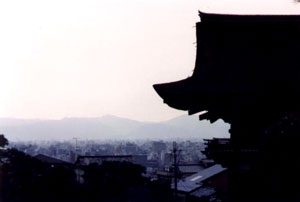

If you are planning to be doing a lot of travelling by train to many different cities, I recommend buying a JR Rail Pass before you go. They come in one, two, and three week incremental sizes. You can ride any JR train or bus as often as you like for the flat price already incurred before you arrived in Japan. This came in very handy while I was staying in Nagoya. I took day trips to Kyoto and Osaka by taking the Shinkansen bullet trains. If you have a train schedule, you can plan out trips to far away cities and back within a day. If you're unfamiliar with train and subway stations (like I was), it's a rather neat experience. Find the train station you wish to travel to and buy a ticket for the amount listed next to its name. When you go through the gates, put the ticket into the slot and it will shoot over to the end of the gate. You've got to hold onto this ticket until you get to your destination. If you have a rail pass, just walk through the disabled access where there should be an employee behind a window. Just flash the rail pass to them and they'll let you through. If you aren't in a big rush and want to take the scenic routes, just use a bus instead and forget about the rail pass. |
That evening, Isao took me to Nagoya's huge summer Matsuri festival. It was crowded. Really crowded. Here I ate takoyaki, grilled pieces of octopus in balls of dough. Good stuff! Man, I miss takoyaki especially right now. There were performers and a parade, but the big finale of the evening was a fireworks show. That night learned that the Japanese word for "fireworks" is hanabi, or "fire flower." That sounds poetic, I think.
The next morning I took the Shinkansen to Kyoto, the cultural capital of Japan. Kyoto was spared during the bombing of Japan because of its rich cultural heritage. I visited a lot of Shinto shrines and Buddhist temples while I was in Japan, especially in Kyoto. Kyoto's major attractions are religious ones; there are so many shrines and temples in the city. All I have to say is that all those people who piss and moan about giving money to Christian churches in America really ought to take a trip to Japan. Imagine a church where you have to pay money to sing a song, pay some more money to pray, and pay some money again to listen to a priest. Some temples and shrines are such a tourist attraction that they'll charge you just to enter in.
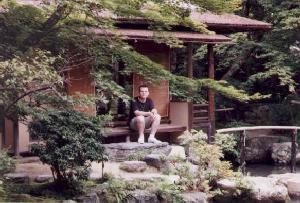 Anyway, enough of this soapbox nonsense. When I arrived at Kyoto Station (which is a sight to see itself for its amazing modern architecture), my first stop was across the street at the JNTO tourism office. I was disappointed to discover that the transportation system in Kyoto is not as developed as in Tokyo or other major cities of Japan. They do have a train and subway system, but they don't seem to stop by anyplace that's real cool to visit. The subway line goes through the middle of the city, and all the train stations seem to be on the outskirts for some reason. As a result, I had to rely on the buses to get around. The buses really didn't seem to make much sense in their routes. Their patterns seemed to go everywhere. You can buy an all-day bus pass for a flat fee. I forget how much, but it's worth it if you plan on moving around a lot. My first destination was Ginkakuji Temple, the Silver Pavillion. On the way there from the bus stop, I saw an interesting place on my map. It was the home of a famous artist, and he had a huge garden. For a reasonable fee, you can take a walk around the garden. I stopped by a restaurant and ate lunch before moving on to the temple. Ginkakuji isn't that spectacular of a place (and neither was the fee), and I've been to better Japanese gardens here in America. The next time I visit Kyoto, I'm going to see Kinkakuji, the Golden Pavillion. The garden there is supposed to be much better too.
Anyway, enough of this soapbox nonsense. When I arrived at Kyoto Station (which is a sight to see itself for its amazing modern architecture), my first stop was across the street at the JNTO tourism office. I was disappointed to discover that the transportation system in Kyoto is not as developed as in Tokyo or other major cities of Japan. They do have a train and subway system, but they don't seem to stop by anyplace that's real cool to visit. The subway line goes through the middle of the city, and all the train stations seem to be on the outskirts for some reason. As a result, I had to rely on the buses to get around. The buses really didn't seem to make much sense in their routes. Their patterns seemed to go everywhere. You can buy an all-day bus pass for a flat fee. I forget how much, but it's worth it if you plan on moving around a lot. My first destination was Ginkakuji Temple, the Silver Pavillion. On the way there from the bus stop, I saw an interesting place on my map. It was the home of a famous artist, and he had a huge garden. For a reasonable fee, you can take a walk around the garden. I stopped by a restaurant and ate lunch before moving on to the temple. Ginkakuji isn't that spectacular of a place (and neither was the fee), and I've been to better Japanese gardens here in America. The next time I visit Kyoto, I'm going to see Kinkakuji, the Golden Pavillion. The garden there is supposed to be much better too.
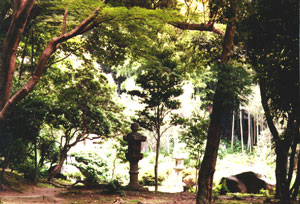
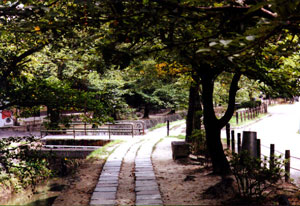
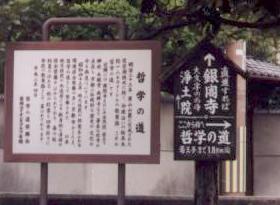 Here's one of the best parts of Kyoto, the Path of Philosophy (Tetsugaku no Michi), which runs from Ginkakuji to Nanzenji. It's a quiet, peaceful walk along the east side of town. The path is along a small canal lined with trees, which I hear are in bloom during the spring. Of course, they weren't blooming in July, but they provided lots of shade. Walking south, there are several shrines and temples along the left, and a quiet neighborhood is on the right with shops facing the canal. Up ahead of me, I saw a couple holding hands. I saw some children catching butterflies with nets. I saw an old man feeding some cats, and a bird trying to catch fish in the canal. The sound of summer insects, the quiet whispering of the water in the canal. Ah! Such nostalgia! As I write this, so many wonderful memories fill my mind. It makes me want to go back to Kyoto and experience it all over again.
Here's one of the best parts of Kyoto, the Path of Philosophy (Tetsugaku no Michi), which runs from Ginkakuji to Nanzenji. It's a quiet, peaceful walk along the east side of town. The path is along a small canal lined with trees, which I hear are in bloom during the spring. Of course, they weren't blooming in July, but they provided lots of shade. Walking south, there are several shrines and temples along the left, and a quiet neighborhood is on the right with shops facing the canal. Up ahead of me, I saw a couple holding hands. I saw some children catching butterflies with nets. I saw an old man feeding some cats, and a bird trying to catch fish in the canal. The sound of summer insects, the quiet whispering of the water in the canal. Ah! Such nostalgia! As I write this, so many wonderful memories fill my mind. It makes me want to go back to Kyoto and experience it all over again. |
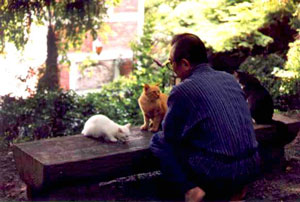
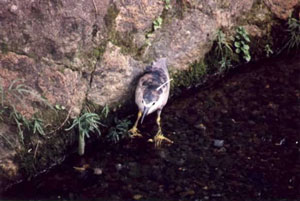
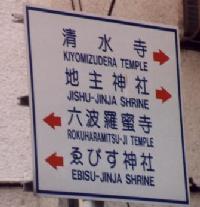
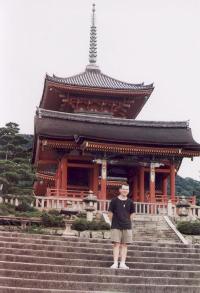 After walking all the way down to Nanzenji, I was disappointed that the Path of Philosophy had ended. I got kinda lost in the neighborhood trying to find a bus stop. When I finally did find it, I sat there for awhile until it came by.
After walking all the way down to Nanzenji, I was disappointed that the Path of Philosophy had ended. I got kinda lost in the neighborhood trying to find a bus stop. When I finally did find it, I sat there for awhile until it came by. I took a bus from the station to see Kiyomizu Dera, one of the many famous temples in Kyoto. The people at the JNTO office can show you how to get there. When you get off at the bus stop, look for this sign on the east side of the street. You'll have to walk uphill for a while until you reach it. This steep street is lined with all sorts of shops and restaurants. The amount of souvenir shops was on par with those of Asakusa's Nakamise. Eventually, you'll reach the end of the street at the top of the hill, where the temple is. From up there, you have an excellent view of the Kyoto cityline. I didn't stay there for a very long time, because it was getting towards sundown and I wanted to get to get to the place I'll talk about in the next paragraph. On the way back down the hill, I stopped by a restaurant and had okonomiyaki with octopus. Yum! |
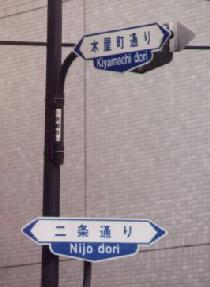
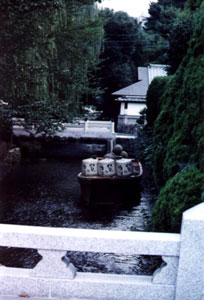 Okay, here's something you probably won't find in any travel books. Not even your Lonely Planet guide book. Starting at the intersection of Nijo Dori and Kiyamachi Dori, you can walk south along a small river, the Takasegawa. As you walk along, a cornucopia of nightlife unfolds before your eyes. I got there right around sundown, and the lighting was perfect. Good thing I had my tripod handy! There isn't much vehicle traffic on the street. In the middle of the city of Kyoto, this is a quiet oasis of tranquility. As you continue along, you'll eventually have to cross an occasional busy street. But once you cross the street, the river starts up again and once again it is serene. Kiyamachi Dori seems out of place somehow in downtown Kyoto.
Okay, here's something you probably won't find in any travel books. Not even your Lonely Planet guide book. Starting at the intersection of Nijo Dori and Kiyamachi Dori, you can walk south along a small river, the Takasegawa. As you walk along, a cornucopia of nightlife unfolds before your eyes. I got there right around sundown, and the lighting was perfect. Good thing I had my tripod handy! There isn't much vehicle traffic on the street. In the middle of the city of Kyoto, this is a quiet oasis of tranquility. As you continue along, you'll eventually have to cross an occasional busy street. But once you cross the street, the river starts up again and once again it is serene. Kiyamachi Dori seems out of place somehow in downtown Kyoto. |
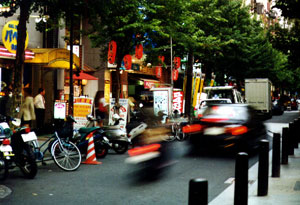
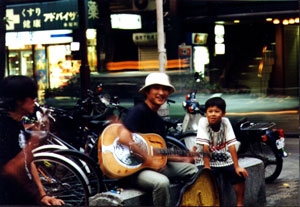
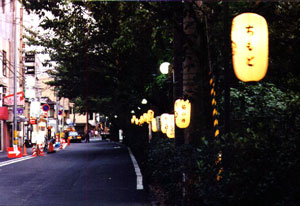 Don't just look straight ahead or you'll miss something! While walking along the streets in Japanese cities, especially while you walk along Kiyamachi Dori, keep glancing left and right and you'll see all sorts of people and things. I glanced to the left and saw narrow alleys with bars with paper lanterns lighting their doors. To the right I saw a little girl walking along with her parents glancing back at me and smiling. On a bench I saw a guy playing guitar who smiled as I took his picture. There was a boy sitting next to him, admiring his musical talents. Once it seems that the canal has disappeared, it re-emerges from the concrete. I'm not sure, but I believe that this canal will lead you all the way down to Pontochou, one of the last remaining geisha districts in Japan. It was getting late at this time, so I had to take a bus back to Kyoto Station to take the Shinkansen back to Nagoya.
Don't just look straight ahead or you'll miss something! While walking along the streets in Japanese cities, especially while you walk along Kiyamachi Dori, keep glancing left and right and you'll see all sorts of people and things. I glanced to the left and saw narrow alleys with bars with paper lanterns lighting their doors. To the right I saw a little girl walking along with her parents glancing back at me and smiling. On a bench I saw a guy playing guitar who smiled as I took his picture. There was a boy sitting next to him, admiring his musical talents. Once it seems that the canal has disappeared, it re-emerges from the concrete. I'm not sure, but I believe that this canal will lead you all the way down to Pontochou, one of the last remaining geisha districts in Japan. It was getting late at this time, so I had to take a bus back to Kyoto Station to take the Shinkansen back to Nagoya.The next day, I took the Shinkansen again to Osaka. But on the way, I stopped off at Kyoto to see one more thing. I wanted to see the Fushimi Inari Shrine. I took the JR Nara line down to Inari Station to see what it was like. There was an ensemble of Japanese performers playing traditional music, and I sat and listened to them for awhile. I wanted to take their picture, but the security guard wouldn't allow me. I don't know why. There's a path that goes all the way up the mountain, and there were torii gates lining the way. It was a long hike up, so I just returned to Kyoto Station and took the Shinkansen to Osaka.
|
I really cannot recommend a trip to Japan alone unless you can speak a bit of the language. Although I was able to speak some basic Japanese well enough to ask directions and to have limited conversations, I still had difficulties communicating. On the other hand, I met several fellow foreigners from various countries travelling Japan alone who could not speak the language at all. I guess it all depends on how adventuresome you are. I had no prior experience with travelling to a foreign country, so I wanted to make sure I could speak enough of the language to get by. You could get by with just speaking English, I suppose, but it would be a bit difficult to find someone who can understand you. However, perhaps since I made it a point to try to speak Japanese, many people who could have helped me in English didn't bother speaking English since they figured I could understand Japanese well. |
Osaka was a real cool experience. If Tokyo is compared to New York and Nagoya is compared to Detroit, then I'd compare Osaka to a city like San Diego or Los Angeles. It was just a real cool place to visit. When I arrived, the first place I sought out was an Internet Cafe to e-mail all my family and friends and to make my friends jealous of where I was. If you've read the other chapters of "Greg's Life," then you'll know that I really like fish. Naturally, I wanted to visit the Osaka Aquarium out in Osaka Harbor Village. I took the above-ground subway (go figure) out to the bayside location. It is a several story tall building filled with all sorts of fish and aquatic life. I guess according to my Lonely Planet book, this is the largest aquarium tank in the world. If you aren't a fish lover like I am, I won't bother you with all the details. But if you are, you have to see it!
After spending much time at the aquarium, I wanted to see Den Den Town, Osaka's equivalent of Akihabara (although not as glamorous and showy). Getting off at Namba Station, I saw that it was a long walk to get there. And in the heat of the day, that didn't seem very appealing. Fortunately, Osaka has several underground shopping malls, and there was one such mall that stretched to the east called the Namba Walk. Perfect! I could then walk half of the way there via the underground in the mall. To get to Den Den Town, take the Namba Walk to Sakasuji Avenue and head south. Keep going, and you'll get there eventually. You'll probably see flags hanging from the lamp posts saying "Den Den Town." There were Famicom stores galore here! I bought all sorts of neat video games here.
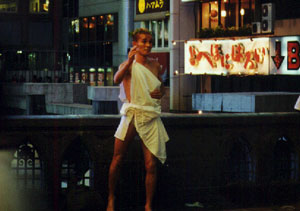

 It was around sundown when I left Den Den Town, and It was a perfect time to see the bright lights of Dotombori at night! This place is so cool. All the travel guide books compare this place to scenes in the movie Bladerunner, which is one of my favorite movies. So naturally I had to see this place. I didn't see Harrison Ford chasing androids through the streets, but it did seem like it could fit into the movie rather well. My Osaka Photography Page has more pictures of this magnificent place. It is a sight to behold. Dotombori is a canal which runs through downtown Osaka, and Dotombori Dori is the street which runs alongside the canal. The whole place is spectacularly lit up at night, and the busy street is crowded with people. So much to see and do there. I was there on a Wednesday night, and it was still very busy. Crowds of people moved either way on the bridges which spanned the canal. I saw a Caucasian guy dressed in some Greco-Roman outfit miming these statue-esque poses on the bridge. I had my picture taken on the bridge with the famous Glico advertisement you see in all the pictures of Dotombori. (In case you don't know, Glico is the company that makes Pocky Sticks. If you don't know what Pocky Sticks are, you're missing out!) I wish I could have stayed there longer, but I had to get back to Nagoya by a reasonable time. I had to run to catch the next Shinkansen, and even then there was no room for me. I had to sit on the floor between cars from Osaka to Kyoto. I still got home fairly late. I was totally exhausted from all the walking around I had been doing the past two days, and my feet ached. Consequently, all the next day I took it easy. I took a nap and wrote all my postcards.
It was around sundown when I left Den Den Town, and It was a perfect time to see the bright lights of Dotombori at night! This place is so cool. All the travel guide books compare this place to scenes in the movie Bladerunner, which is one of my favorite movies. So naturally I had to see this place. I didn't see Harrison Ford chasing androids through the streets, but it did seem like it could fit into the movie rather well. My Osaka Photography Page has more pictures of this magnificent place. It is a sight to behold. Dotombori is a canal which runs through downtown Osaka, and Dotombori Dori is the street which runs alongside the canal. The whole place is spectacularly lit up at night, and the busy street is crowded with people. So much to see and do there. I was there on a Wednesday night, and it was still very busy. Crowds of people moved either way on the bridges which spanned the canal. I saw a Caucasian guy dressed in some Greco-Roman outfit miming these statue-esque poses on the bridge. I had my picture taken on the bridge with the famous Glico advertisement you see in all the pictures of Dotombori. (In case you don't know, Glico is the company that makes Pocky Sticks. If you don't know what Pocky Sticks are, you're missing out!) I wish I could have stayed there longer, but I had to get back to Nagoya by a reasonable time. I had to run to catch the next Shinkansen, and even then there was no room for me. I had to sit on the floor between cars from Osaka to Kyoto. I still got home fairly late. I was totally exhausted from all the walking around I had been doing the past two days, and my feet ached. Consequently, all the next day I took it easy. I took a nap and wrote all my postcards.
That weekend, my friend Isao took me to many places. I coudn't even remember the names of all the places he took me. We visited Nagoya Castle, which is actually a rebuilding of the original which was burned to the ground during World War II. I can't imagine why. I'd like to think that bombing is a fairly precise military activity, but with the way the Chinese Embassy was accidentally bombed this year I suppose that things tend to get sloppy. Only the exterior of the castle was accurate; the interior was just a museum that even had an elevator. After the castle, Isao took me to a virtual labyrinth of an underground shopping mall. It must've stretched for miles, and I would have gotten lost if I wasn't with him.
The other places worth mentioning that I visited was Inuyama Castle and Meiji Mura in Gifu-ken that Sunday. Meiji Mura is a place where many historical landmark buildings from all over Japan have been saved from demolition and transferred to Meiji Mura. Inuyama Castle is the oldest surviving castle in Japan, and its interior is left intact. So, it's quite impressive compared to Nagoya Castle. This castle gives you a better idea of what it would be like to have lived in a castle as a shogun.
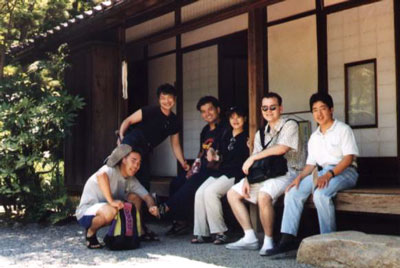
![]() For images of Osaka, visit my Osaka Photography Page
For images of Osaka, visit my Osaka Photography Page
 Go back to the "Greg's Life" Table of Contents
Go back to the "Greg's Life" Table of Contents

"Oh no! It's Kabuki men!" --The Toxic Avenger